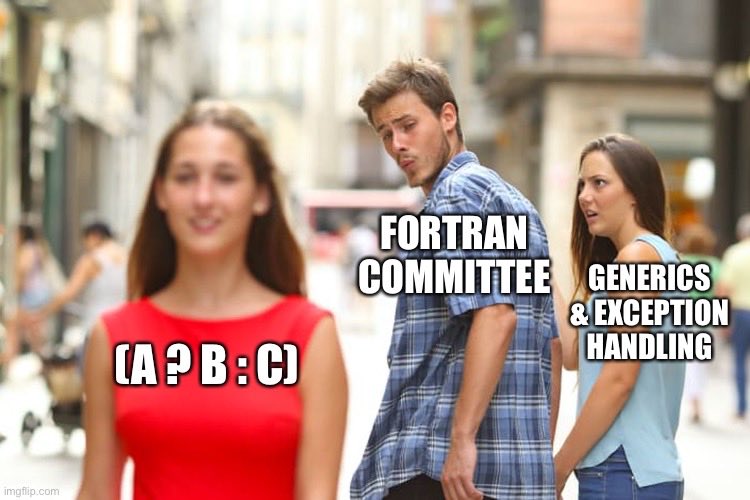The New Features of Fortran 202x

The glacially slow pace of Fortran language development continues! From the smoke-filled room of the Fortran Standards Committee, the next Fortran standard is coming along. It has not yet been given an official name but is currently referred to as "Fortran 202x" (so hopefully we will see it before the end of this decade). Recall that Fortran 90 was originally referred to as "Fortran 198x".
A document (from John Reid) describing the new features is available here and is summarized below:
- The limit on line length has been increased to ten thousand characters, and the limit on total statement length (with all continuation lines) has been increased to a million characters.
- Allocatable-length character variables were added in Fortran 2003, but were ignored by all intrinsic procedures, until now! Better late than never, I suppose. In Fortran 202x, intrinsic routines that return strings can now be passed an allocatable string and it will be auto-allocated to the correct size. This is actually a pretty great addition, since it fixes an annoyance that we've had to live with for 20 years. Of course, what we really need is a real intrinsic string class. Maybe in 20 more years we can have that.
typeofandclassof. No idea what these are for. Probably a half-baked generics feature? What we really need is a real generics feature. Since that is in work for Fortran 202y I don't know why these have been added now. Probably we will discover in 10 years that these aren't good for much, but will be stuck with them until the end of time (see parameterized derived types).- Conditional expressions. This adds the dreadful C-style
(a ? b : c)conditional expression to Fortran. Somebody thought this was a good idea? This abomination can also be passed to an optional procedure argument, with a new.nil.construct to signify not present. - Improvements to the half-baked binary, octal, and hexadecimal constants.
- Two string parsing routines (
splitandtokenize) were added. These are basically Fortran 90 style string routines that I guess are OK, but why bother? Or why limit to just these two? See above comment about adding a real string class. - Trig functions that accept input in degrees have been added (e.g.
sind,cosd, etc). These are already commonly available as extensions in many compilers, so now they will just be standardized. - Half revolution trig function have also been added (
acospi,asinpi, etc.). I have no idea what these are good for. - A
selected_logical_kindfunction was added. This was a missing function that goes along with theselected_real_kindandselected_int_kindfunctions that were added in Fortran 2003. Logical type parameters (e.g.,logical8,logical16, etc. were also added to the intrinsiciso_fortran_envmodule). - Some updates to the
system_clockintrinsic. - Some new functions in the
ieee_arithmeticmodule for conformance with the 2020 IEEE standard. - Update to the
c_f_pointerintrinsic procedure to allow for specifying the lower bound. - New procedures were added to
iso_c_bindingfor conversion between Fortran and C strings. This is nice, since everyone who ever used this feature had to write these themselves. So, now they will be built in. - A new
ATformat code, which is likeA, but trims the trailing space from a string. Another nice little change that will save a lot oftrim()functions. - Opening a file now includes a new option for setting the leading zeros in real numbers (print them or suppress them).
- Public namelists can now include private variables. Sure, why not?
- Some updates for coarrays (coarrays are the built-in MPI like component of Fortran).
- A new
simpleprocedure specification. Asimpleprocedure is sort of a superpureprocedure that doesn't reference any variables outside of the procedure. Presumably, this would allow some additional optimizations from the compiler. - A new "multiple subscript" array feature. The syntax for this is just dreadful (using the
@character in Fortran for the first time). - Integer arrays can now be used to specify the rank and bounds of an array. I tried to read the description of this, but don't get it. Maybe it's useful for something.
- Can now specify the rank of a variable using an integer constant. This is nice, and makes the
rankparts of the language a little more consistent with the other parts. Again, this is something that is cleaning up a half-baked feature from a previous standard. - Reduction specifier for
do concurrent, which is putting more OpenMP-like control into the actual language (but just enough so people will still complain that is isn't enough). enumerationtypes have been added for some reason. In addition, the half-baked Fortran 2003enumhas been extended so it can now be used to create a new type. I'm not entirely sure why we now have two different ways to do this.

So, there you have it. There are some nice additions that current users of Fortran will appreciate. It will likely be years before compilers implement all of this though. Fortran 202x will be the 3rd minor update of Fortran since Fortran 2003 was released 20 years ago. Unfortunately, there really isn't much here that is going to convince anybody new to start using Fortran (or to switch from Python or Julia). What we need are major additions to bring Fortran up to speed where it has fallen behind (e.g., in such areas as generics, exception handling, and string manipulation). Or how about some radical upgrades like automatic differentiation or built-in units for variables?
References
- J. Reid, The new features of Fortran 202x, ISO/IEC JTC1/SC22/WG5 N2194, March 21, 2022
- JTC1/SC22/WG5
- INCITS PL22.3, the US Fortran Programming Language Standards Technical Committee
- The new features of Fortran 2015 (degenerateconic.com)